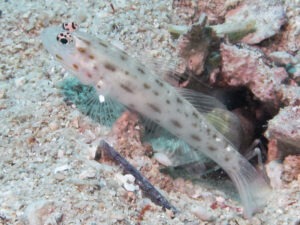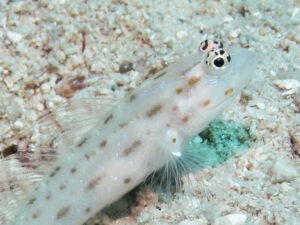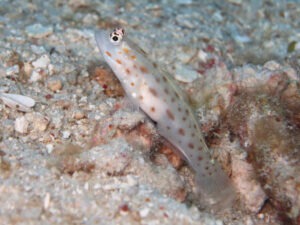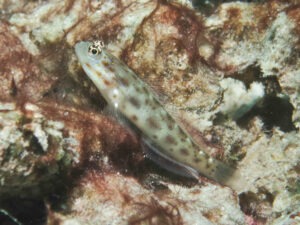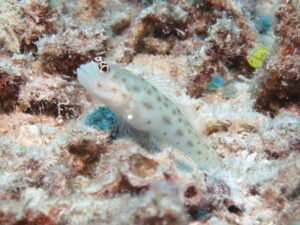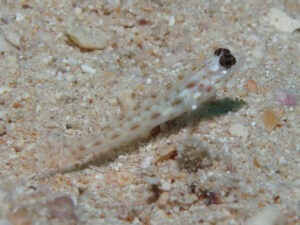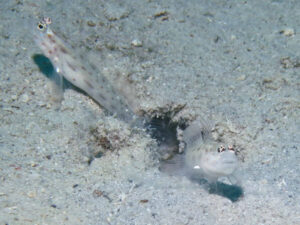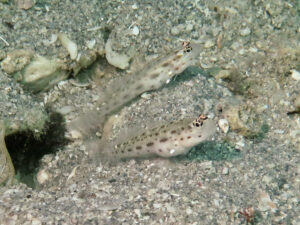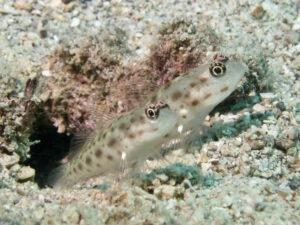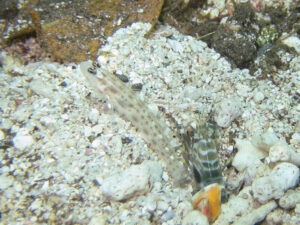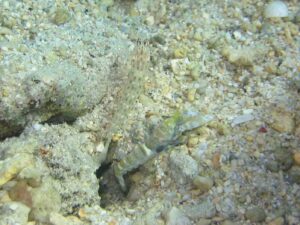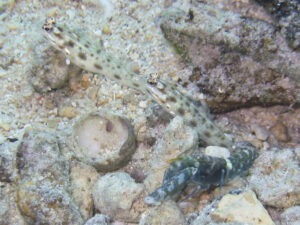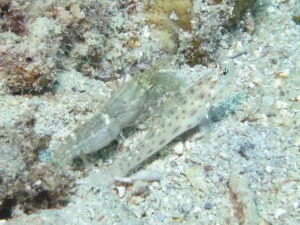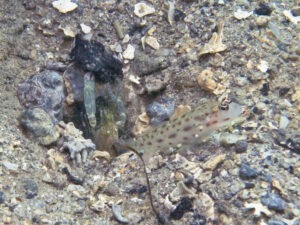Thread Shrimpgoby
Ctenogobiops mitodes
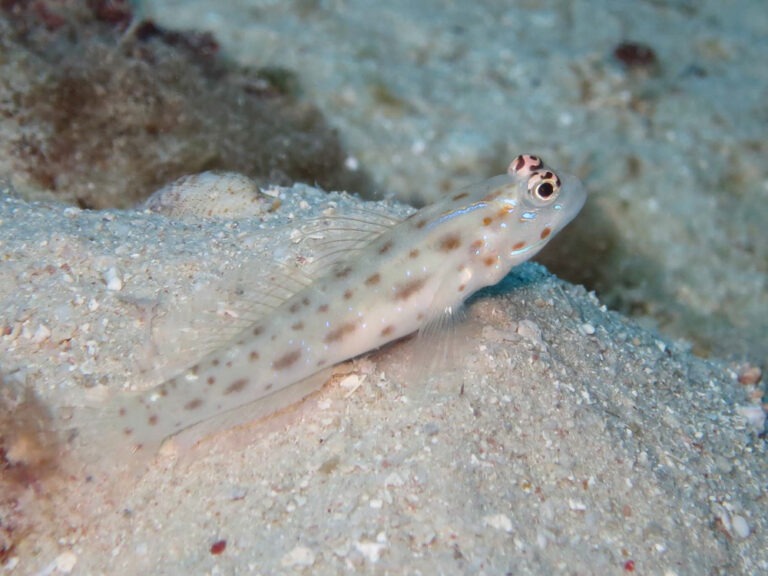
Thread Shrimpgoby
Ctenogobiops mitodes
Randall, Shao and Chen, 2007
Description
Body design
This is a small almost translucent shrimp goby, about 7 cm long, with six oval patches along the body. Between these and offset above and below are two longitudinal rows of circular spots. These are dark grey.
The facial markings consist of a single row of three spots that slope slightly upwards from the maxilla to the gill cover. There seems to be a slightly pigmented skin fold running under these three spots. The three spots may take the form of a line. (Thacker et al 2010, Randall et al 2007)
With suitable illumination blue reflective lines are visible on the face.
Fin design
The dorsal fins are transparent with a grey base. The first dorsal fin is triangular and has extended rays, the second being the longest. There is a white patch on the transparent pectoral fin and another at its base. Ventral and caudal fins are transparent. The pelvic fin is pale grey proximally, becoming purple then blue.
Diagnostic features
This species needs to be distinguished from C pomastictus. It differs in that the dark outlined gold spots between the brown body patches are uniformly dark grey.
The facial markings differ also: instead of three spots in a straight line along a skin fold, C pomastictus. has five spots arranged in two rows. The first spot of the upper row below the posterior edge of the eye and the last on the opercle; the second row commences with a spot above the rear end of the maxilla, and the remaining two or three spots curve ventrally as they pass posteriorly.
The elongated second dorsal ray is a further differentiating feature.
The species of Ctenogobiops may be difficult to tell apart. Apart from C tangaroai, with its distinctive dorsal fin, they are differentiated by head and body patterns.
Head patterns
C aurocingulus 16 bright orange markings in four rows of four in the shape of a trapezoid starting at the angle of the jaw
C feroculus has no head pattern.
C crocineus has a series of broken diagonal lines covering the whole area from the nose to the gill covers.
C mitodes has three spots in a straight line along a skin fold running back and upwards from the angle of the mandible
C pomastictus has three spots curving ventrally, running back from the angle of the mandible. Above these, there are three spots in a horizontal straight line below the level of the eye.
Body patterns
C aurocingulus has fine gold bars running through lateral patches
C feroculus have poorly defined lateral patches only
C crocineus have lateral decoration arranged in parallel lines
C mitodes have small brown spots below the level of lateral patches
C pomastictus have dark-outlined orange spots below patches
Similar species
Other species of shrimpgobies of the genus Ctenogobiops and several small transparent sand gobies are similar-looking
C feroculus is very plain with a line of brown patches along the side of the body and little other decoration. These patches are oval with an ill-defined edge. No head pattern.
C aurocingulus has a series of orange vertical lines running through lateral blotches to the underside. The arrangement of 16 bright orange markings in the shape of a trapezoid on the head is useful in identification
C crocineus which has many oval and circular brown patches arranged in defined lines along the body. The head is decorated with a series of broken diagonal lines covering the area from the nose to the gill covers.
Natural History
Habitat
C mitodes are found in coarse, sandy substrate with plentiful coral and shell fragments. This is usually In shallow water and always close to the reef or rocky outcrops, but the depth varies from 1 to 35 metres.
Behaviour
The tissue surrounding the eyes is usually pink with a pattern of brown but can change to uniformly black. We speculate that the obvious pink colour is used for signalling to others of its species.
Distribution
Published distribution
East Indian region (Indonesia, Papua New Guinea, Solomon Islands) to Fiji and the Marshall Islands, Australia (Great Barrier Reef) to the South China Sea.
Our records
Australia; Lizard Island, Ribbon Reefs, Whitsunday Islands.
New Caledonia; Pilots Bay, Ile Ouen.
Solomon Islands; Guzo, Russell and Kolombangara Islands
Associated Shrimp species
Associated Shrimps (five species)
Banded Snapping Shrimp, Alpheus species 1
Black-sided Snapping Shrimp, Alpheus cf djeddensis
Dark Marbled Snapping Shrimp, Alpheus macellarius
Green Snapping Shrimp, Alpheus species 4
Pale Marbled Snapping Shrimp, Alpheus djiboutensis

